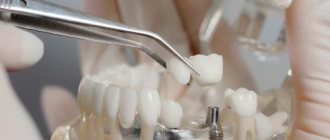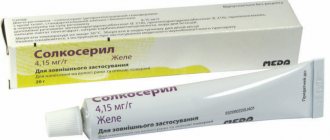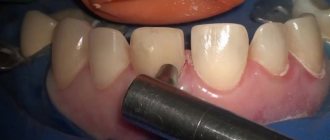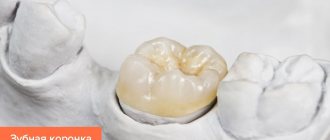A crown is the name in dentistry for a prosthesis that is placed on a tooth, on an implanted implant, or included in the structure of a dental bridge. With the help of dental crowns, you can restore severely damaged or lost teeth, the restoration of which must be carried out urgently and for this you must contact a dentist.
How the crown will be installed, whether it hurts to put a crown on a tooth - we will answer all these questions in detail in our article.
When is it necessary to put a crown on a tooth: indications for restoring teeth with a crown
The need to place a crown on a tooth may arise in the following situations:
- The tooth is severely damaged by caries. If the natural crown of a tooth is damaged by more than 50% by caries, then it would be more correct to put a crown on the tooth rather than restore it with a filling. Large fillings do not withstand the chewing load well and may fall out or break, and the tooth may break along with the filling. If the root of the tooth is damaged, then it will have to be removed. By placing a crown on a decayed tooth, you have the opportunity to save it;
- The tooth is destroyed as a result of trauma. If the roots of a tooth were not affected by injury, it is possible to restore the tooth - it will be enough to put a crown on it;
- You can also put a crown on a tooth for aesthetic restoration: for example, if a tooth is chipped or its enamel has changed color, becoming gray or yellow, and this defect cannot be eliminated by classic whitening.
Doctors recommend placing temporary crowns to preserve teeth for patients with periodontitis. In this case, crowns prevent teeth from becoming loose and falling out.
In your case, do you need to put a crown on your tooth or is it possible to use another restoration method? The doctors of our dental clinic in Moscow, “Firadent,” can help you find the answer to this question. To make an appointment with our specialists, you just need to dial our dental clinic’s phone number!
Frequently asked questions to the doctor
Implant rejection
I heard that implants are rejected in most cases, is this true?
In fact, such a situation occurs. In rare cases, the body may not accept the implant. But still, as practice shows, in 95% of cases such surgical intervention is successful, and the person receives beautiful and straight teeth. Don’t be afraid, you just need to choose a good specialist and clinic.
Prosthetics
I would like to know why prosthetics are necessary?
Prosthetics are primarily necessary to ensure that chewing function is restored. First of all, this includes gastroenterological indications, because if the food is chopped poorly, the stomach will begin to work incorrectly.
I need to put a crown on a tooth: is the treatment painful?
Statistics show that most people, knowing that they need to put a crown on a tooth, still postpone their treatment for fear of visiting the dentist and the pain that supposedly cannot be avoided with dental prosthetics. Does it really hurt to put a crown on a tooth? Let's look at this issue together.
So is it painful to put a crown on a tooth or not? The most painful stage in the process of installing a crown on a tooth will be the preparation, during which the teeth are treated for caries, depulped (if necessary), and also ground down to the thickness of the future crown. All these procedures are not performed without anesthesia, as they can cause quite severe pain to the person.
Before you begin to treat and prepare the tooth for placing a crown on it, the doctor will definitely perform an anesthesia procedure using a local anesthetic. The type and amount of the drug are selected individually for each patient. The use of anesthesia makes the process of preparing the tooth for crown installation painless.
If the patient experiences a literally panicky fear of dentists, in our dental clinic “Firadent” he may be offered dental treatment in his sleep[/anchor], under sedation. Sedation should not be confused with general anesthesia; it is a light medicated sleep in which the patient will remain during treatment. Sedation allows you to relieve the patient not only from pain when preparing teeth for prosthetics, but also from psychological discomfort and stress! Moreover, after sedation there are no negative side effects, which are not uncommon after general anesthesia.
You can read all the details on dental treatment during sleep in a separate article on our website, which is devoted to sedation, or find out during a consultation with the doctors of our clinic - “Firadent”.
Which method is better
There is no treatment that suits everyone, so the dentist decides which method to use based on the clinical picture and the data collected. Tissue augmentation may be impossible for a number of reasons, or artificial gum cannot be used for various reasons. Large clinics will consider both options because they have the basis for using either option. In small dentistry, the doctor may lack experience in tissue transplantation, or the technicians may not have the material to make artificial gum on the prosthesis.
Initial examination and diagnosis
The decision that a crown needs to be placed on a tooth is made by an orthopedic dentist after examining the patient’s oral cavity and teeth, as well as performing a number of diagnostic measures. Based on the data obtained, the orthopedist will develop a treatment plan, which may include not only the installation procedure itself, but also a number of additional measures:
- Professional oral hygiene, which allows you to clean your teeth from plaque and tartar;
- Removal of severely damaged teeth that cannot be properly treated and restored with a filling;
- Treatment of caries and any other diseases of the teeth and gums diagnosed during examination;
- Tooth removal, treatment and filling of canals.
Note that depulping a tooth before placing a crown on it is not always done. The depulpation procedure involves removing the dental nerve, after which the tooth becomes more fragile and vulnerable to external factors. If a tooth has more than one root and is in good condition, doctors prefer not to remove the dental nerve and put a crown on a living tooth.
When drawing up a treatment plan, the question of what kind of crown will be placed on the tooth is also decided. Modern dental crowns are made from different materials and there is always the opportunity to choose the version of the prosthesis that will most suit the patient in terms of aesthetics, price and durability.
The drawn up treatment plan is agreed with the patient and after agreement the treatment process begins. The first step is to prepare the tooth for the installation of a crown.
Mini-implantation and overdentures
Mini-implants are designed to improve the fixation of removable nylon dentures on the patient's jaw. Such dentures are sometimes called overlay dentures. This method refers to conditionally removable prosthetic methods.
Mini-implants serve as support for overdentures, and fixation (clicking) is carried out using silicone matrices. The simplest and most convenient is the spherical (push-button) fastening, which requires the implantation of at least 2-4 implants. The greater the number of supports, the more reliable the fixation will be, the less likelihood of bone tissue atrophy, but the higher the overall cost of prosthetics.
The main advantages of mini implantation are reliable fixation of the prosthesis, the ability to install implants without incisions, the ability to install a covering prosthesis immediately after, no need for bone grafting, and the cost is lower when compared with classical implantation.
The main disadvantages are that the plastic base cannot cope with loads like real teeth, the load is still not distributed evenly enough, and fixed prosthetics are not feasible.
Preparing to install a dental crown
Preparing for a dental crown may include the following procedures:
- Professional teeth cleaning. Removing tartar and plaque from the surfaces of teeth will help you accurately select the color of the future crown, as well as identify primary caries and other diseases that are important to cure before placing a crown on the tooth.
- Treatment of caries, pulpitis, periodontitis, and gum inflammation. You can’t put a crown on sick teeth!
- Treatment of the tooth on which a crown will be placed. During this process, the doctor will drill out the tooth and remove all tissue affected by caries. If necessary, tooth depulpation is carried out, as well as treatment and filling of dental canals.
IMPORTANT: Dental canal treatment must be of high quality! If during the treatment of the canals the doctor makes a mistake, does not remove all the tissues affected by inflammation, or fills the canals incorrectly, the tooth may begin to hurt already under the crown, and then it will have to be removed and treated again! In our dental clinic “Firadent” in Moscow, treatment of tooth canals is carried out under a microscope with an optical device, which allows the doctor not to act at random, but to accurately see the length and internal space of the dental canals, and therefore carry out the procedure with impeccable quality.
After filling the canals, the tooth is restored with a filling and the next stage in prosthetics begins - turning the tooth under a crown.
Installation of prostheses
When the crowns or dental bridges are ready, the final stage of prosthetics will begin. Installation of structures is carried out in accordance with the chosen method. If removable dentures are performed, the doctor shows the patient how to properly put on and remove the structure from the mouth. A specialist fixes permanent crowns and bridges in such a way that they are securely held on the supporting elements. There is no need to remove such dentures yourself; they remain in the oral cavity permanently.
Before installation, fittings are carried out to show whether adjustment (correction) of the structure is required. After the patient approves the prosthesis, the dentist performs its final fixation.
Grinding a tooth for a crown
Before placing a crown on a tooth, the tooth must be ground to the thickness of the future prosthesis. This procedure in professional dentistry is called “preparation”. The enamel of the tooth is ground down with a drill and during the treatment the doctor will give the tooth a shape that will allow the crown to be placed firmly and tightly.
IMPORTANT: Grinding of live teeth can be quite painful, so local anesthesia must be administered before performing this procedure. If the tooth was depulped before grinding, local anesthesia may not be used, the procedure will not cause pain.
When preparing teeth, a layer of tissue is removed from the tooth before placing a crown. The thickness of the layer will depend on how thick the crown will be. A minimal layer of tissue is removed from the teeth for cast crowns; a significant layer of tissue must be removed from the tooth if it is decided to install ceramic or metal-ceramic crowns. On average, during the grinding process, about 2.5 mm of tissue is removed from a tooth on each side.
As a result of tooth preparation, a core base (stump) is obtained, on which the doctor will place a crown.
Oral examination
Any treatment process must begin with an examination. A preliminary examination allows you to determine the need for prosthetics, choose the optimal type of design and amount of work.
Examination of the oral cavity in dentistry Additional examination (instrumental, x-ray, etc.) provides information about the condition of the supporting teeth, periodontal tissue, bone tissue, the need for root canal treatment, and the possible presence of inflammatory elements at the tops of the root canals or in the bone.
This is an integral stage of successful prosthetics, as it allows not only to identify and eliminate hidden problems, but also to avoid possible complications in the future, after installation of the prosthesis .
Making crowns
Crowns are made from an impression that is taken from the prepared teeth. To obtain this impression, the orthodontist will use a special plastic mass. Based on the impression taken, the laboratory will first make a plaster model of the prosthesis, and then a crown, which will be placed on the tooth.
Modern dental crowns are made from different materials: metal, ceramic, metal-ceramic and zirconium. The timing of the production of the prosthesis will depend on what kind of crown it is decided to place on the tooth. Crowns made of ceramics and metal-ceramics take the longest to produce. So that a person does not have to walk without a tooth during the entire time of making the crowns, a temporary plastic prosthesis is put on the tooth.
IMPORTANT: Temporary plastic crowns help hide a defect in the dentition; a person will not have to be embarrassed by the absence of a tooth and experience stress for this reason. Also, temporary dentures help protect a ground and therefore weakened tooth from the negative effects of environmental factors and bacteria.
Neuromuscular occlusion
The position of the lower jaw in space affects posture and the condition of the skull bones. Any misalignment of the lower jaw, caused by multiple missing teeth or an incorrectly designed bite during the fabrication of complete dentures, causes the cervical vertebrae to become misaligned as they attempt to balance the situation. The entire spine shifts according to these changes to achieve balance, which disrupts normal posture. On the other hand, tensions from incorrectly and asymmetrically working masticatory muscles are transmitted through the teeth to the bones of the skull, and as a result, neurological reactions can occur, expressed as chronic headaches, especially in the temples and in the suboccipital region, dizziness, clicking in the temporomandibular joints, neck pain, blurred vision and hearing, numbness in the fingertips.
When determining the position of the lower jaw, a state of neuromuscular bite is achieved, and not the usual one, for which the muscles are affected by electrical impulses. Electrical exposure time is about 45 minutes. The muscles relax and the jaw moves from its usual position to a physiological one. Then a graph of the movement of the lower jaw and muscle work is taken (computed myography).
The found correct position of the lower jaw is used in the design of dentures. Osteopathic correction helps compensate for muscle imbalance caused by the new unusual position of the lower jaw. Neuromuscular occlusion maintains the health of the entire body and ensures the longevity of dentures.
If we take into account the natural interaction of the anatomical parts and the tension of the neuromuscular fibers, as well as the natural position of the former dentition, the prosthesis will stay more securely in the mouth in the position of non-closing teeth and function better without causing inconvenience and unpleasant sensations.
Try-on, temporary and permanent fixation of the crown
Before placing a crown on a tooth, it must be tried on. For this purpose, the patient is invited to the clinic. During the fitting, the accuracy of the crown's manufacturing and the tightness of its fit on the stump base are assessed. If the fitting does not reveal manufacturing inaccuracies, the patient does not feel discomfort and is satisfied with the aesthetics of the finished product - a temporary fixation of the crown is performed on the tooth.
What is temporary fixation? This is a kind of “test drive” of the crown. With a crown placed on a temporary basis, the patient will walk for a certain period of time (usually up to 4 weeks). If during this time no defects or inaccuracies are identified in the manufacture of the crowns, the patient comes to the clinic and the crown is placed and fixed with permanent dental cement.
At this point, the crown installation process can be considered complete.
Artificial gum method
With this method, a crown with an artificial gum is installed, which imitates the real one in color and shape. The gingival margin here is always clearly defined, the height of the teeth is anatomically correct, and the smile is attractive. The edge of the gums and papillae (small triangles between the teeth) are modeled from a special material, so the structure looks natural. Patient photographs clearly demonstrate the attractive aesthetics of such restoration.
How to place a crown on an implant?
A crown can be placed not only on a tooth, but also on an implant. This allows you to restore lost teeth without grinding down healthy units in the rows. Crowns on implants are durable, aesthetic, and visually indistinguishable from natural teeth.
Before placing a crown on an implant, an artificial root implantation procedure is performed. As soon as the implant takes root, an abutment is placed on it, and then a crown. Putting a crown on an implant will be more expensive than conventional prosthetics, but the price of the service is fully compensated by the impeccable aesthetics and long service life of both the implant and the crown.
How to insert a tooth if there is no root?
If you have had a tooth removed, you can insert it using implantation, and this can be done immediately after the extraction procedure - using the method of one-step implantation. With this method of tooth restoration, implants are implanted directly into the socket of the extracted tooth and then a temporary prosthesis is placed on them. Simultaneous implantation will allow you to insert a tooth and not walk with an unpleasant dentition defect. The doctor will install a permanent crown on the implant abutment after it has fused with the bone - this usually takes 3-4 months.
Implantation is recognized as the most reliable and durable way to restore extracted and lost teeth, but it is not always possible to replace teeth with it - there is a fairly wide range of contraindications for this surgical operation.
Crown service life
Patients who plan to get a crown are often interested in its useful lifespan. The service life of a crown placed on a tooth will depend on a number of factors:
- Crown material and technology;
- The patient’s compliance with all doctor’s recommendations for crown care;
- Quality of preparation of teeth for prosthetics.
The last factor is of fundamental importance: if mistakes are made during the preparation and manufacturing of the crown, the crown will not last long, and undesirable complications may arise, due to which the crown will have to be removed and re-installed on the tooth. For these reasons, you need to very carefully choose the clinic where you plan to treat and restore your teeth! Remember that the worst type of saving is saving on your own health!
The crown must be placed in a well-equipped dental clinic, staffed by experienced orthopedic doctors and dental technicians. The clinic must use the most modern technologies for diagnostics, treatment and dental prosthetics; only this approach to the choice of dentistry guarantees high quality treatment!
Removable dentures - what are they?
Removable dentures are devices that partially or completely replace lost teeth. A distinctive feature of removable structures is the ability for the patient to remove and put them on independently. This feature unites all types of removable dentures with a significant variety of types and models.
Despite the advantages of modern fixed prosthetics, removable dentures also have their advantages:
- relatively low price;
- ease of manufacture and operation of the orthopedist;
- the ability to choose a manufacturing material that is suitable in price and quality;
- the ability to restore any defect in the dentition;
- lightness of the prosthesis, the ability to choose the desired shade of material;
- no need to prepare healthy teeth for prosthetics;
- the ability to repair a damaged model in a dental laboratory;
- ease of care.
Removable dentures solve the problem of restoring the aesthetic and chewing function of teeth when they are lost and it is impossible to establish a fixed model, and therefore increase the quality of human life.
How much does it cost to put a crown on a tooth?
How much does it cost to put a crown on a tooth? It is difficult to give a definite and precise answer to this question, because the cost of installing a crown may include various additional but necessary procedures. For example, professional teeth cleaning, treatment of caries or pulpitis, treatment and filling of canals.
The cost of installing a crown will be influenced by both the material and the production technology of the prosthesis. The most expensive options are ceramic and zirconium crowns produced using CAD/CAM technology. But such crowns fully pay for their cost due to their high strength, reliability and aesthetics.
Also, the cost of installing a crown will depend on how it will be placed - on an abutment tooth or on an implant.
The best way to find out how much it costs to put a crown on a tooth is to come to an appointment with orthopedic doctors at our dental clinic in Moscow - “Firadent”. Experienced specialists of our dentistry will conduct an examination and diagnosis and draw up a treatment plan, which will indicate the exact price of the service.
Dentures for partially missing teeth on implants
Single implant and crown
The titanium root replaces the root of the tooth, and the crown replaces its visible part. Thus, we receive a one-piece single restoration, with which we can fully restore the aesthetics and functionality of the natural tooth.
Bridge prosthesis on implants
Restoring a missing piece of teeth using single implants will be expensive, so it is much more logical to use a bridge for this purpose. Artificial crowns attached to each other are placed on two or three implants (depending on the number of teeth being restored). The materials used are cermets, ceramics and zirconium dioxide.










